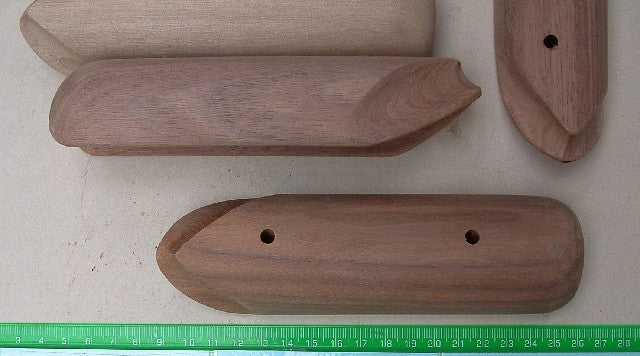On Paper Optics
Sniper Cheek Piece (Walnut) for No4(T) & L42A1 Rifle Reproduction
Couldn't load pickup availability
These are reproduction sniper cheekpieces for the Enfield No4(T) or L42A1 rifle.
Modelled from an original item, these cheek pieces are hand finished and are made from solid walnut.
These are offered 'in the white', which is unstained with no protective finish, ready for whichever colour and finish will match your individual rifle. As these were modelled from an original unfitted cheek piece some minor fitting may be required so that these will fit your rifle perfectly, just as the originals needed to be matched to their individual butts. As with the original cheek pieces the screw holes have been left as drilled and are not countersunk. This job would have been performed by the unit Armourer to match the screws used and the user’s individual preference.
Supplied with a pair of both the correct pattern brass screws and steel screws for fitting to give you the choice.
Also available in Left Hand please leave a note at check out
Fitting a New Sniper Cheek Piece
The cheekpiece position is more or less universal rather than designed for a fixed position. When we fitted these to the L42's they were always fitted for the individual firer of the rifle, very rarely was one fitted up 'generically'. The optimum way of doing it is to employ an assistant with a steady hand, a pencil and a sharp 3" nail which will slide through the screw holes easily. A strong elastic band that will stretch around the butt and the cheekpiece will greatly assist in the process as well.
Firstly get into the prone position with your rifle and adopt a comfortable firing position. When in position, get your assistant to mark with the pencil the line of your thumb where it naturally sits on the wrist of the butt. Next, place the cheekpiece on the top of the butt and secure it in place with the elastic band, the front of the cheek piece where it is cut away for the thumb should be roughly aligned with the pencil line on the butt. Get back into the prone position and move the cheekpiece side to side until it is in the correct place for your cheek to rest on it when your eye is aligned with the telescope. At this stage, you will need to use a little 'artist discretion' as the cheekpiece will naturally be a little higher than its final position when it is trimmed down to fit flush with the butt.
Once you are happy with its placement move your head away and get your assistant to carefully mark the screw holes by pushing the nail through the screw holes in the cheekpiece and indenting the butt. The 'standard' screws used to fit the cheek pieces were No8 wood screws with countersunk heads, either steel or brass, (for function and strength use steel if you are going to use it in the wet a lot use brass), the front screw being 1 1/2" long the rear being 1 1/4" long. Drill pilot holes carefully into the butt to suit using the indents made by the nail as guides. ENSURE THAT THE SCREW HOLES ARE IN THE SAME PLANE AS EACH OTHER, if you can keep the cheekpiece in place on the butt whilst you at least start the pilot holes this will help.
All that is required now is to exercise a little patience and trim down the side pieces of the underside of the cheekpiece until the cheekpiece fits snugly onto the butt. A good tip here is to find 2 nails that slide snugly into the pilot holes in the butt. Remove the heads from the nails and then slide the cheekpiece down over them each time you trial-fit it. This ensures that the cheekpiece will always be in the same position. If you rub coloured blackboard chalk over the top of the butt each time you trial fit the cheek piece chalk will be left on the underside where you need to remove wood. I would recommend using a half-round rasp for trimming down. It sounds like a complex process, but really it is quite easy once you get into it. How good the final fit depends on how much time and patience you can devote to the job, however, if you are going for 'authenticity' then remember that there are only so many hours in a day and armourers working on the 'real thing' were more interested in function than form. A solidly mounted cheekpiece was far more important than a perfect cabinet maker's finish with no gaps!
Finally, before finishing the job, countersink the screw head holes in the top of the cheekpiece. For a top-quality job countersink the holes so that the screw heads sit about 3mm below the surface and once screwed fully home fill the holes with plugs made from dowel glued in place and trimmed flush. Again for 'authenticity' this was rarely done on service weapons although it was by no means unknown.






